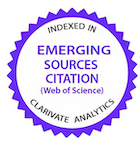Produção de bovinos de corte em pastagem de aveia preta e azevém submetida à adubação nitrogenada
DOI:
https://doi.org/10.5216/cab.v14i2.21068Palavras-chave:
Bezerros, Eficiência do nitrogênio, Ganho de peso, PastoResumo
Determinou-se a produção de bovinos em pastagem de aveia preta (Avena strigosa Schreb.) e azevém (Lolium multiflorum Lam.), submetida à adubação nitrogenada com 0; 150 e 300 kg de N ha-1, em cobertura, sob a forma de ureia. Utilizaram-se 36 bezerros como animais-teste, com idade média e peso de 10,5 meses e 180 kg, respectivamente. O método de pastejo foi o de lotação contínua com taxa de lotação variável. O delineamento experimental foi em blocos ao acaso, com três repetições (piquetes). O ganho de peso médio dos animais foi similar para os níveis de adubação avaliados (0,925; 0,969 e 1,045 kg dia-1, respectivamente). A taxa de lotação e ganho de peso vivo por hectare aumentaram linearmente com o incremento das doses de nitrogênio. A eficiência na produção animal foi 2,040 e 1,766 kg de ganho de peso por kg de nitrogênio aplicado, para as doses de 150 e 300 kg de N de nitrogênio, respectivamente. A taxa de lotação e o ganho de peso vivo por hectare dos bezerros de corte aumentaram com as doses de nitrogênio, de 0 a 300 kg de N ha-1; porém, a melhor eficiência em ganho de peso por unidade de nitrogênio aplicado foi obtida na dose de 150 kg de N ha-1.
PALAVRAS-CHAVE: bezerros; eficiência do nitrogênio; ganho de peso; pasto.
Downloads
Publicado
Como Citar
Edição
Seção
Licença
Copyright (c) 2013 Ciência Animal Brasileira / Brazilian Animal Science

Este trabalho está licenciado sob uma licença Creative Commons Attribution 4.0 International License.
Autores que publicam nesta revista concordam com os seguintes termos:
- Autores mantém os direitos autorais e concedem à revista o direito de primeira publicação, com o trabalho simultaneamente licenciado sob a Licença Creative Commons Attribution que permite o compartilhamento do trabalho com reconhecimento da autoria e publicação inicial nesta revista.
- Autores têm autorização para assumir contratos adicionais separadamente, para distribuição não-exclusiva da versão do trabalho publicada nesta revista (ex.: publicar em repositório institucional ou como capítulo de livro), com reconhecimento de autoria e publicação inicial nesta revista.
- Autores têm permissão e são estimulados a publicar e distribuir seu trabalho online (ex.: em repositórios institucionais ou na sua página pessoal) a qualquer ponto antes ou durante o processo editorial, já que isso pode gerar alterações produtivas, bem como aumentar o impacto e a citação do trabalho publicado (Veja O Efeito do Acesso Livre).






























